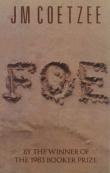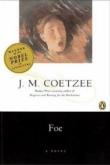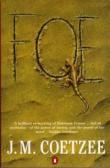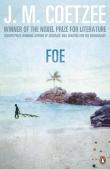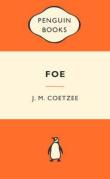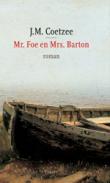AustLit
Latest Issues
AbstractHistoryArchive Description
'In the early eighteenth century, a woman finds herself set adrift from a mutinous ship and cast ashore on a remote desert island. There she finds shelter with its only other inhabitants: a man named Cruso and his tongueless slave Friday. In time, she builds a life for herself as Cruso's companion and, eventually, his lover.' (Source: Libraries Australia)
Notes
-
Editions and translations have been updated for Foe by Eilish Copelin as part of a Semester 2, 2013 scholar's internship. The selection and inclusion of these editions and translations was based on their availability through Australian libraries, namely through the search facilities of Libraries Australia and Trove (National Library of Australia).
Given the international popularity of Coetzee's work, however, this record is not yet comprehensive. Editions and translations not widely available in Australia may not have been indexed. Furthermore, due to the enormous breadth of critical material on Coetzee's work, indexing of secondary sources is also not complete.
Publication Details of Only Known VersionEarliest 2 Known Versions of
Other Formats
- Also sound recording and large print.
Works about this Work
-
Foe
2023
single work
criticism
— Appears in: The Bloomsbury Handbook to J. M. Coetzee 2023; (p. 115-126) -
Robinsonaden in the Feminine? Coetzee’s Foe and Muriel Spark’s Robinson
2019
single work
criticism
— Appears in: Reading Coetzee's Women 2019; (p. 129-147) Examines Coetzee's Foe against Muriel Spark's Robinson, including the link between literature, politics, and power. -
She and Her Man : Foe
2019
single work
review
— Appears in: Sydney Review of Books , October 2019;
— Review of Foe 1986 single work novel'In the remarks that preface his 2003 Nobel Lecture, entitled ‘He and His Man’ (worth watching on YouTube for the dry comedy of the delivery alone), J. M. Coetzee speaks of reading The Strange and Surprising Adventures of Robinson Crusoe when he was ‘eight or nine’. Presumably this was an abridged children’s version of the kind many of us read at that age. He would not have been alone when he fell in love with this ‘desert island that became a kingdom’, or when Crusoe became ‘a figure in my imagination’. Less predictable, perhaps, was his bewilderment at the claim in his Children’s Encyclopaedia that the author of the book was someone called Daniel Defoe. ‘This made no sense,’ he continues, ‘because it said on the first page of Robinson Crusoe that Robinson Crusoe told the story himself.’(Introduction)'
-
Thresholds of the Novel : Realism, the Inhuman, the Ethical in J. M. Coetzee's Foe
2018
single work
criticism
— Appears in: Novel : A Forum on Fiction , vol. 51 no. 3 2018; (p. 438-460)'The end of a novel is the site of particular epistemic privilege. If the form is governed by a biographical master plot, the “meaning of the life,” as Benjamin has it, is “revealed only in [the] death” that is the plot's narrative limit—and beyond this limit “the novelist . . . cannot hope to take the smallest step.” Such a limit is seemingly crossed in one of the most difficult and quite possibly the strangest of passages in J. M. Coetzee's fiction: the ending of Foe. This book's self-conscious re-presentation of the origins of the English novel (and of Defoe's inauguration of the genre's biographical pattern) culminates in a surreal encounter that Coetzee's readers have claimed limns a restorative justice or a utopic futurity. But these interpretations ignore the text's insistence on a silence that overwhelms language, the specter of mass death, and a summative darkness that attend upon this place. What might it mean, in fact, for Foe's ending to cross the Novel's thresholds only to stage a total “blackout” of the realist novel's meaning-producing mechanism and the story of individual experience the genre has valorized? This article draws on Coetzee's unpublished notebooks and the Foe ur-text to argue that the novel proposes an impossible crossing, whereby key strategies we have used to value the genre—its capacity to summon countervoices or to invoke an ethical response to alterity—are shadowed by a radical question about the limits of our readerly attention.' (Publication abstract)
-
‘In Every Story There Is a Silence’ : Translating Coetzee’s Female Narrators into Italian
2018
single work
criticism
— Appears in: Australian Literary Studies , February vol. 33 no. 1 2018;'Translating is not only an exercise in the restoration of meaning. The translator’s true challenge lies in restoring meaning while preserving the way in which that meaning is expressed, because style is what is unique to a text. While working on a book, translators find many obstacles along their path in the form of innate tendencies, that are very difficult to resist and that deform and manipulate the stylistic features of the text. Working on Coetzee’s novels, this is particularly true when the narrator telling the story is a woman, due to specific aspects of translating gender. In my article I will explore some of the issues I faced when I translated into Italian two of Coetzee’s novels, In the Heart of the Country (1978) and Foe (1986). On one side, in telling Magda’s and Susan’s stories in Italian, the translator has to resist the temptation to rationalise the narrator’s language or to fill in the silence pervading the two novels just to make the text more coherent. And on the other side, she has to find a suitable language with regard to both diction and syntax, and to look for a way to address the question of what Magda calls ‘the pronouns of intimacy’, when the female and the colonised subject are marginalised by patriarchal authority.' (Publication abstract)
-
She and Her Man : Foe
2019
single work
review
— Appears in: Sydney Review of Books , October 2019;
— Review of Foe 1986 single work novel'In the remarks that preface his 2003 Nobel Lecture, entitled ‘He and His Man’ (worth watching on YouTube for the dry comedy of the delivery alone), J. M. Coetzee speaks of reading The Strange and Surprising Adventures of Robinson Crusoe when he was ‘eight or nine’. Presumably this was an abridged children’s version of the kind many of us read at that age. He would not have been alone when he fell in love with this ‘desert island that became a kingdom’, or when Crusoe became ‘a figure in my imagination’. Less predictable, perhaps, was his bewilderment at the claim in his Children’s Encyclopaedia that the author of the book was someone called Daniel Defoe. ‘This made no sense,’ he continues, ‘because it said on the first page of Robinson Crusoe that Robinson Crusoe told the story himself.’(Introduction)'
-
Teaching Coetzee’s Foe in an Undergraduate Theory Classroom
2014
single work
criticism
— Appears in: Approaches to Teaching Coetzee's Disgrace and Other Works 2014; (p. 180-186) -
Father to My Story : Writing Foe, De-authorizing (De)Foe
2005
single work
criticism
— Appears in: Revista Alicantina de Estudios Ingleses , no. 18 2005; (p. 7-24) 'Foe is probably not J.M. Coetzee's best known novel, although it is a text of great importance because of the way in which its political, literary and theoretical values are interrelated. The novel addresses a foundational myth of Western societies in the figure of Robinson Crusoe, and draws attention to its textual quality. This concern with the process of representation and the narrative quality of our beliefs is also manifested throughout the novel in other issues. Thus, in the text there is a whole panoply of reflections about the central issues affecting the very mechanics of constructing a text, such as, for example, the proper way a story should be written, the relationship between representation and its referent in the real, the problem of realism, or the question of authorship.' (Publication abstract) -
The Spiritual Liberation of Music, Dance, and Ritual : Verbal-versus Non-verbal Communication in J. M. Coetzee's 'Foe'
2015
single work
criticism
— Appears in: Commonwealth Essays and Studies , Autumn vol. 38 no. 1 2015; (p. 11-20) ' In exploring the power and diverse means of communication reflected in J. M. Coetzee's Foe (1986), this article considers the nature, musicality, and limitations of language - both written and oral. It investigates the sway of non-verbal communication, reflected through the spiritually liberating forms of story-making, music, dance, and ritual. Dexterity in Afro-American dances (Capoeira, Candombl , and Calypso) is contemplated with regard to Foe's Bahian setting and Friday's performing abilities.' (Publication abstract) -
Dialogues of Memory, Heritage and Transformation : Re-membering Contested Identities and Spaces in Postcolonial South African and Zimbabwean White Writings
2016
single work
criticism
— Appears in: Journal of Literary Studies , September vol. 32 no. 3 2016; (p. 59-76) 'The protean and contested symbols of Zimbabwean literature remain the land and invented heroes, including a hagiographic iconisation of shrines, best seen in the Zimbabwe ruins, the Zimbabwe Bird and the national heroes’ acre. In South African white writings, the symbolic topos has been dominated by prison walls, the hangman’s noose, Robben Island and, in the post-apartheid era, Saartjie Baartman and the imagined rainbow generated through the Truth and Reconciliation Commission (TRC). The horrors of apartheid are ideographically embodied in Coetzee’s tongueless protagonist, Foe. In both locales, white writings – fictive renditions and auto/biographical – have invited critically legitimated constructs of coherence. This article contends that answers to our present postcolonial crises inhere in the multiplicity of voices, not monological narratives. Diversity, and therefore polyphony, is valued for its ability to suggest multiple ways of seeing and belonging to national imaginaries; its ability to suggest answers to the postcolonial problematic related to memory, heritage and transformation. This article explores how the meanings of cultural objects often display shifting appropriations that garner either symbolic or ephemeral qualities, demonstrating the ability of those in power at different historical junctures to determine and confer minted meanings. In turn, this anxiety and re-membering of space and symbol has a bearing on ownership claims, and gives rise to a choreographed heritage discourse.' (Publication abstract) -
‘In Every Story There Is a Silence’ : Translating Coetzee’s Female Narrators into Italian
2018
single work
criticism
— Appears in: Australian Literary Studies , February vol. 33 no. 1 2018;'Translating is not only an exercise in the restoration of meaning. The translator’s true challenge lies in restoring meaning while preserving the way in which that meaning is expressed, because style is what is unique to a text. While working on a book, translators find many obstacles along their path in the form of innate tendencies, that are very difficult to resist and that deform and manipulate the stylistic features of the text. Working on Coetzee’s novels, this is particularly true when the narrator telling the story is a woman, due to specific aspects of translating gender. In my article I will explore some of the issues I faced when I translated into Italian two of Coetzee’s novels, In the Heart of the Country (1978) and Foe (1986). On one side, in telling Magda’s and Susan’s stories in Italian, the translator has to resist the temptation to rationalise the narrator’s language or to fill in the silence pervading the two novels just to make the text more coherent. And on the other side, she has to find a suitable language with regard to both diction and syntax, and to look for a way to address the question of what Magda calls ‘the pronouns of intimacy’, when the female and the colonised subject are marginalised by patriarchal authority.' (Publication abstract)

